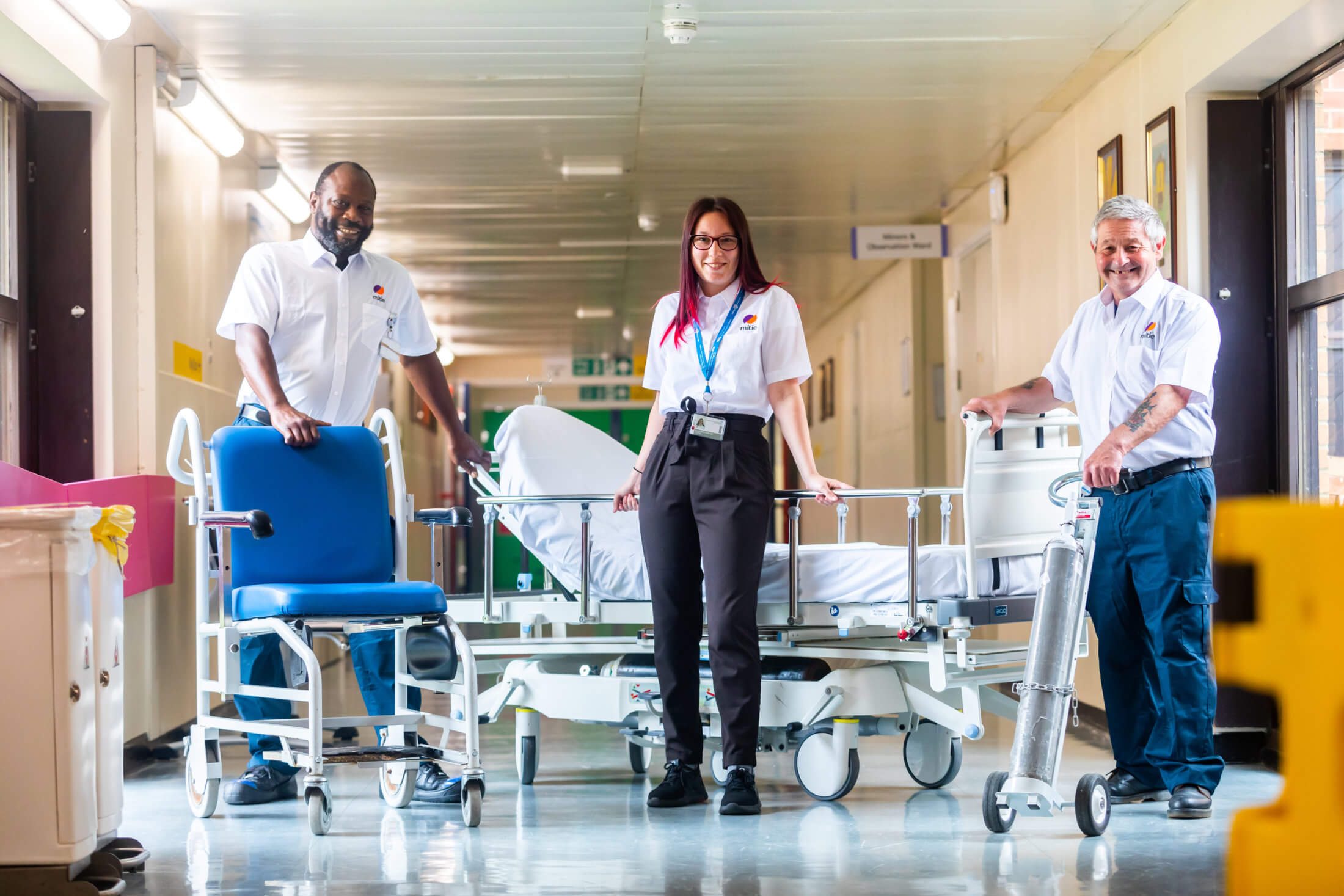The National Cleanliness Standards
Answering the demand of the National Standards of Healthcare Cleanliness
By Martyn Hearn
Account Director, Mitie Healthcare
Prevention before cure: How Mitie’s approach manages broad and complex changes of the National Cleaning Standards
The impact of change
The National Standards of Healthcare Cleanliness 2021 (often referred to as the National Cleaning Standards) reintroduce the term ‘standard’. All NHS healthcare establishments in England must adhere to the changes, which necessitate a detailed understanding of requirements specific to every NHS Trust.
A diverse group of healthcare and facilities management specialists, including Mitie, contributed to the new standards sharing best practices and evolving standards from across the industry.
Effective management of the new standards for healthcare organisations isn’t for the fainthearted. It’s a continuous, sizeable, yet necessary body of work that can bring cost savings and efficiencies if managed correctly. Mitie’s intelligent, data-driven approach supports NHS Trusts’ transition to the new National Standards of Healthcare Cleanliness 2021, focusing on collaboration.
Demand-led services
The standards encourage demand-led cleaning of high footfall areas. We use sensors, feedback and call buttons that quickly alert and direct the teams to areas requiring cleaning due to high usage, depleted consumables, spillages, or incidents.
This demand-led cleaning ensures services are delivered based upon need and level of use, rather than by simply following arbitrary, routine cleaning schedules. Collaboration is vital to ensure this is implemented seamlessly, with a solid process to manage any eventualities that arise.
Quantitative cleaning audits
To supplement visual auditing methods, which are typically used in healthcare, we’ve introduced quantitative auditing methods. We often use adenosine triphosphate (ATP) for NHS Trusts to measure the standard of cleanliness. In this way, we can measure how clean something is, rather than just look and say, is it clean or dirty?
Another way cleaning can be measured is with the use of fluorescent markers, often used as a training aid; fluorescent marking gels and powders work with UV Flashlights to provide a quick, objective view of the effectiveness of the cleaning process. Each of these solutions offers data insight to influence cleaning planning.
Expectations of wide-ranging demand
The standards are designed for ease of use; they offer freedom within a framework, providing a level of service that maintains the efficacy of the cleaning process, whilst ensuring it remains fit for the future. The desired outcome is assured cleanliness with transparency of results for patients and NHS Clients alike. This wide-ranging remit highlights the need for more progressive solutions to ensure the successful implementation of the new standards.
The scope of the task for many NHS Trusts is enormous because each NHS Trust must apply the standards across a broad remit. The road ahead is fraught with challenges; making decisions such as categorising the risk in functional areas and agreeing on responsibilities means suppliers and clients need to find common ground.
Having a well-thought-through strategy to communicate implementation and ensuring the right stakeholders are involved is essential for NHS Trusts. We’re confident our supportive and multidisciplinary approach will smooth the way for the challenging journey ahead.
The importance of data
Data management is critical to provide real-time views of activity and performance. Mitie’s inhouse experts and specialist suppliers develop the best technology and data capture systems for our NHS Trust clients. The data gathered enables us to produce meaningful Management Information (MI) relating to Mitie’s cleaning service, performance and intelligent performance dashboards uniquely tailored for each hospital. It’s an initiative driven by Alice Woodwark, Managing Director, Mitie Communities, who champions taming technology with a human approach.
Mitie’s detailed National Standards of Healthcare Cleanliness 2021 Assessment Toolkit utilises our knowledge and expertise in healthcare cleaning to accurately assess the impact of the new standards on each functional area. The toolkit clearly outlines the risk category and task responsibilities with a written rationale for how these have been derived. The strategy and plan will be reviewed at least annually, or when there is a significant change in clinical activity, to ensure the rationale and risk ratings are still appropriate.
Mitie’s robust and logical way of implementing the new cleaning standards gives our clients confidence in the successful delivery and access to clear data that demonstrates our progress.
Alice Woodwark, Managing Director, Mitie Communities
Mitigating the impact of change
Only a robust approach can confidently address the standards with so many changes requiring detailed review. Accurately assessing the impact of an element cleaning frequency change requires knowing each element’s productivity rate (time to clean).
Several sources of cleaning productivity rates are available. Essential to understanding the impact of change, therefore, is the need to establish which rates are the most accurate and effective. Industry associations, including the Official ISSA Cleaning Times & Tasks, publish the most widely accepted sources. Mitie reviews and implements a combination of productivity rates with one-to-one task timings where established rates are unavailable.
Cleaning managers visit each hospital functional area, counting the elements. This exercise provides detailed assessment data, helping to identify the overall impact of change to develop new staffing rosters, training requirements, reports, and dashboards.
Our process is designed to identify deficiencies in some areas and surplus labour in others. Our task is to allow our clients to maximise the resources they possess, redistributing and focusing where necessary.
Humanising the power of technology
Data, science, and technology are essential, but we must ensure the human touch is not lost. Many parts of the new standards such as cleaning responsibilities and the adoption and blending of risk categories, can be adapted to meet local needs and reviewed regularly. Working in partnership with multiple stakeholders, Mitie brings unrivalled expertise and new approaches needed to deliver the standards.
Audit risk categories have increased from four to six, resulting in more complex auditing and reporting requirements. Additionally, auditing technology needs to be compliant with the new star-rating system of scoring. Star ratings will be assessed according to the robust audit processes in the National Standards of Healthcare Cleanliness 2021. Star ratings are intended as a visual guide for the public to reassure them the hospital has been cleaned to the high standards expected.
The Mitie toolkit in action
To standardise and drive the rollout of the standards, we created the Mitie toolkit. Working in partnership with clients and stakeholders, the Mitie model helps assess, implement, review, and modify in real-time. Maximising data is at the heart of developing a toolkit that embraces a people-first approach.
Barking, Havering and Redbridge University Hospitals NHS Trust (BHRUT) have welcomed Mitie’s toolkit and the proposed changes, seeing them as an excellent opportunity to agree on a common standard for delivering and measuring services across different areas of the Trust. They have also welcomed initiatives for clinical colleagues and teams to be more involved with the delivery of the cleaning standards.
Kevin Leader; Head of Estates & Facilities at BHRUT recognises Mitie is in the early stages of planning and sees the merit of the agile toolkit, “There are several ways to approach the implementation of the standards, Mitie has embraced this, and we’re pleased with the progress overall. Only by working in collaboration can we evolve, moving fluidly to address the new standards, ensuring the delivery promises meet the demands of our Trust and the rapidly changing environment”.
Case Study: King George Hospital
- New facilities opened by King George V in July 1931.
- The Baker Memorial Wing completed in January 1935.
- Joined the NHS in 1948.
- 1 of 2 hospitals under BHRUT*
- Teaches students from Barts and The London School of Medicine and Dentistry
- One of busiest emergency departments in London
* Barking, Havering and Redbridge University Hospitals NHS Trust

Departments
Wards
Beds
sq. m
Single standards benefit
Adopting single standards is extremely beneficial for King George Hospital. It’s essential to ensure the same standard is delivered across all hospitals in this multi-site Trust. “It’s an excellent opportunity for the Trust to compare and align services for different hospitals across Private Finance Initiative (PFI) and retained estates, which is crucial because they have different contracts and expectations,” explains Kevin Leader, Head of Estates and Facilities at Barking, Havering and Redbridge University Hospitals NHS Trust.
Implementing the new standards
Previously standards may have only been audited by the domestic team. Now with a formal joint audit process, there is more direct input from the clinical team. This is a positive thing, and it’s an excellent opportunity for the Trust to reset the position in terms of cleaning and for everybody to understand what’s required.
The Trust will better appreciate the objectives and the reasoning behind it. The public will be able to see visible and logical star ratings. “It’s a positive driver for organisations to work towards continuous improvement. Publicising ratings in entrances and accessible areas is a real benefit. It will drive services and performance upwards, focusing NHS Trusts on delivering better services,” Kevin says.
We’re working with Mitie because we need to be confident the right specialists are in place to assist us in navigating the changes.
Kevin Leader, Head of Estates & Facilities Corporate, Estates, Barking, Havering and Redbridge University Hospitals NHS Trust and Facilities
Multi-disciplinary teams
Identifying the right individuals is important. Specific individuals are invited to meetings, including the chief nurse, silver command nurses and site director. Kevin explains, “We can see to some degree what’s transpiring and test knowledge or awareness at the end of processes. Our colleagues must understand the thinking, approach, and delivery we’re implementing. This can only be achieved with full engagement with two-way dialogue. Questions need to be asked and answered.”
The engagement of clinical teams is critical to managing winter pressures where there may be issues around the resource, which Kevin highlights. “The NHS faces staffing shortages in many clinical areas. Heading into winter there will be more challenges. We’ll probably need to adapt and think of flexible ways to support clinical and cleaning monitoring.”
Maximising resource
Kevin cautions it will be necessary to assess and apply slightly different ways of achieving the same result with the resource challenge the NHS Trust may experience. Having the right specialists and resources is critical to facilitate success. As Kevin explains, “There has been the right level of resources put into gathering the information across the hospital. We haven’t had the opportunity to test any of that yet, but we will test some sample areas to ensure we’re all aligned. I expect that the service will be resourced satisfactorily to achieve the correct result.”
Alice Woodwark, Managing Director, Mitie Communities summarises how Mitie’s initiatives lead the way, developing the practical approach to working with National Cleaning Standards, “We’ve developed and champion the Science of Service. This brings data and modern technology to our work, increasing quality and reducing cost. The Science of Service is essential to the successful delivery of the new National Standards of Healthcare Cleanliness. It allows us to deliver the benefits of these modern new standards in a way that enhances value for our clients, patients and workforce.
Popular Content

Intelligent Healthcare
The future of healthcare is evolving rapidly with advances in digital healthcare technologies. Mitie’s unrivalled approach combines a human approach with technology to facilitate an earnest, empathetic and efficacious service.

Four Challenges Facing Healthcare FM Managers During COVID-19 Recovery…
What four main challenges are healthcare facilities managers facing in the pandemic? And what ways can facilities management partners support them?

The Future of Healthcare Facilities Management
t has been a disruptive year for the healthcare industry so far. What lessons can healthcare estate facilities managers take forward into 2022? Insights from Alice Woodwark, Managing Director Mitie Communities
How can we help?
If you’re looking for more information, need to talk to someone about an enquiry or want to chat about your service needs, then you’ve come to the right place.
Please fill in our short form and a member of our Healthcare team will be in touch.
 Skip to content
Skip to content